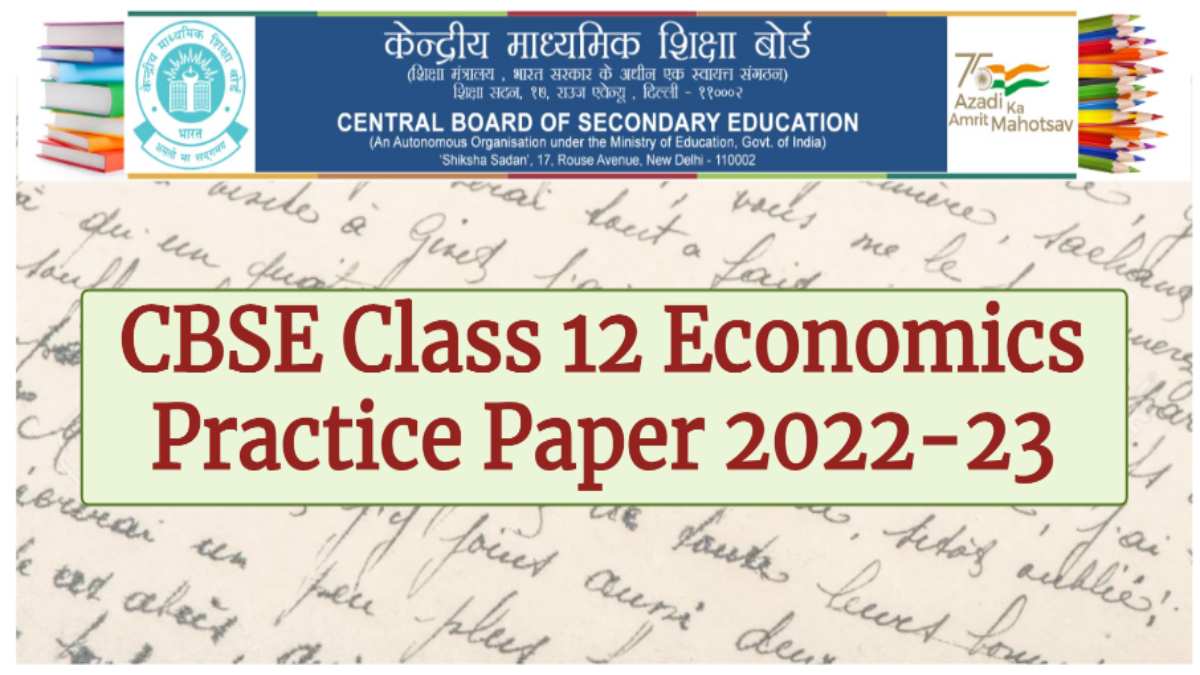Jagran Josh
CBSE Class 12 Economics Practice Paper 2023: Download CBSE practice paper of Class 12 Economics to practice important questions for the upcoming CBSE Class 12th Economics Board Exam 2023. Check marking scheme to read answers of all questions. Download 12th class Economics practice paper and marking scheme in PDF here.

CBSE Class 12 Economics Practice Paper 2022-23
CBSE Class 12th Economics Board Exam 2023: This article is to help the students of CBSE Class 12 Economics who are preparing for their upcoming Economics exam scheduled for 17th March 2023, Friday. As a Class 12 Economics 2022-23 student you may use this benefit by solving the practice paper discussed in this article. You may use the Marking scheme too for the same.
For CBSE Class 12 Economics Exam preparation, CBSE has released practice questions other than the CBSE Class 12 Economics Sample Paper 2022-23. The content of the Class 12 Economics Practice Paper has been curated by the CBSE educators. Thus, students should use them as an important part of their Class 12th Economics Board Exam 2023 preparation. The questions given in CBSE Class 12th Economics Practice Paper will help you in self-assessment. After going through the CBSE Class 12th Economics Practice Paper and Marking Scheme you will be able to strengthen your weak topics before time. This article also provides the PDF of CBSE Class 12th Economics Marking Scheme to help the students get an idea on the answers. This will help them to know the answers to all questions for quick revision before the exam. Download the CBSE Class 12 Economics Practice Paper 2023 and Marking Scheme in PDF here.
Related:
Practice Questions
Session 2022-23
ECONOMICS (030)
CLASS: XII
Time: 3 Hours Maximum Marks: 80
GENERAL INSTRUCTIONS:
- This question paper contains two sections: Section A – Macro Economics, Section B – Indian Economic Development
- This paper contains 20 Multiple Choice Questions type questions of 1 mark each.
- This paper contains 4 Short Answer Questions type questions of 3 marks each to be answered in 60 to 80 words.
- This paper contains 6 Short Answer Questions type questions of 4 marks each to be answered in 80 to 100 words.
- This paper contains 4 Long Answer Questions type questions of 6 marks each to be answered in 100 to 150 words.
|
Section A |
||
|
Q. No |
Question |
Marks |
|
Q1 |
Read the following statements carefully: Statement 1: Aggregate demand is the sum total of consumption and investment expenditures. Statement 2: Total consumption consists of an autonomous component and an induced component. Choose the correct option based on the above statements. A. Statement 1 is true and statement 2 is false B. Statement 1 is false and statement 2 is true C. Both statements 1 and 2 are true D. Both statements 1 and 2 are false |
1 |
|
Q2 |
“The World Bank has been extending loans to Country X on favourable terms for infrastructure, poverty alleviation, and rural development projects for four decades.” Identify the reason for these loans to be listed as external assistance under the capital account of the Balance of Payments. A. The loans have been taken from an entity outside the country. B. The loans aim to improve the standard of living in the country. C. The loans have crossed the three-decade period. D. The loans can be paid off over a longer period. |
1 |
|
Q3 |
The Reserve Bank of India can increase the money supply in the economy by ____________. (Choose the correct alternative) A. demonetisation of currency B. buying government bonds C. increasing the cash reserve ratio D. persuading banks to discourage loans |
1 |
|
Q4 |
There are two statements given below, marked as Statement (1) and Statement (2). Read the statements and choose the correct option. Statement (1): The Balance of Payments is a key economic indicator of a country’s economic well-being. Statement (2): It is a summary of all economic transactions of a country and the rest of the world in a given financial year. A. Statement 1 is true and statement 2 is false B. Statement 1 is false and statement 2 is true C. Both statements 1 and 2 are true D. Both statements 1 and 2 are false |
1 |
|
Q5 |
Given below are some basic activities that occur in an economy. Identify the activity that would not help to study the economy in its totality? A. government introducing policies B. aggregate demand and supply of goods C. determination of the consumer’s equilibrium D. determination of equilibrium level of income and employment OR The total consumption and investment curves are given below: Identify which of the following represents “Autonomous Consumption”. A. OR B. RC C. RY D. RI |
1 |
|
Q6 |
As the Marginal Propensity to Save (MPS) increases, the value of the investment multiplier ____________. (Choose the correct alternative) A. increases B. decreases C. becomes zero D. does not change OR What is the value of the investment multiplier, when the Marginal Propensity to Consume (MPC) is 0.1? A. 10 B. 1.1 C. 0.01 D. 100 |
1 |
|
Q7 |
Which of these do not fall under the purview of the Central Bank? P: controlling money supply Q: providing loans to citizens R: issuing currency S: holding foreign exchange reserves Alternatives: A. only S B. only Q C. Q and S D. P and R |
1 |
|
Q8 |
The money exchanged in which of the following situations will not be considered as Invisible items under the Balance of Payments? A. An Indian flying to the US for his medical treatment. B. Oil India Limited (OIL) purchasing crude oil from Iraq. C. The Indian diaspora remitting money to their families at home D. Tata consultancy services (TCS) providing cloud consulting to African nations. OR Identify the situation that can be certainly deduced from a “capital and current account equilibrium”? A. The current account deficit is financed by the selling of foreign exchanges. B. There is an inverse relationship between the current and the capital account. C. The capital account has to be equal to the current account to achieve equilibrium. D. The country is running into an economic deficit and requires borrowing from foreign reserves. |
1 |
|
Q9 |
There are two statements given below, marked as Statement (1) and Statement (2). Read the statements and choose the correct option. Statement (1) When aggregate supply is plotted as a 45°line graph, the economy is said to be at equilibrium. Statement (2) The total amount spent on aggregate demand is equal to the total expenditure in the country. A. Statement 1 is true and statement 2 is false B. Statement 1 is false and statement 2 is true C. Both statements 1 and 2 are true D. Both statements 1 and 2 are false |
1 |
|
Q10 |
Choose the equation that represents the equilibrium condition in a two-sector economy.
|
1 |
To check all questions, download the full practice paper from the link mentioned below:
CBSE Practice Paper 2023 for Class 12 Economics: PDF Download
You can check answers to all questions given in the above CBSE Class 12 Economics Practice Paper from the marking scheme cum paper solution from the following link:
Marking Scheme for CBSE Class 12 Economics Practice Paper 2023
Some other important resources for CBSE Class 12 Economics Board Exam can be checked in the links below for quick and effective preparation:
FAQ
Q2: Is it compulsory to attempt all the questions in Class 12 Economics Board Exam?
Ans: Yes, CBSE Class 12th Economics question paper 2023 will have a total of 34 questions. All these questions will be compulsory. A few of them may have choices. This will provide the students a benefit to attempt the question based on their knowledge and confidence in the question.
Q1: CBSE Class 12 Economics Practice Paper 2023 is divided into how many sections?
Ans: CBSE Class 12 Economics Practice Paper is divided into 2 sections named A and B. Section A will have the questions from Macro Economics. Section B will have questions from Indian Economic Development. Each section contains a different set of questions along with markings. Number of questions and marking of each type are as follows: The total number of questions will be 34 out of which have 20 Multiple Choice Questions 1 mark each, 4 Short Answer type Questions 3 marks each, 4 Short Answer type Questions 4 marks each, and 4 Long Answer type Questions 6 marks each.
#CBSE #Class #Economics #Practice #Paper #Marking #Scheme #Minute #Revision #Download #PDF

